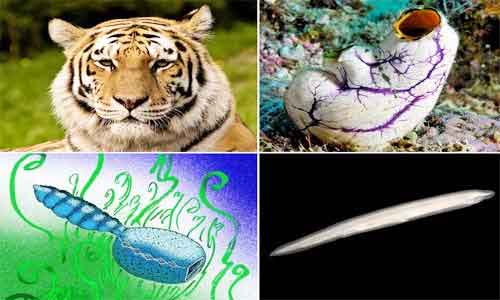The chordates were originated from a fish-like ancestor, very similar to the larva of the Ascidia (Tunicata) and it is assumed that they became the ancestor of the chordates by retaining the larval form throughout the life. In the palaeozoic age, the chordates were originated from some sessile Echinoderms, which were bottom dwellers of the sea. The primitive chordates resemble the non-chordates in some respects and are known as protochordates or invertebrate chordates. In the evolutionary course, They acquired new novelties and became vertebrates that were radiated on all ecological niches and became strong rivals of the non-chordates in the course of time. The phylum chordata is a very diverse phylum which contains about 43,000 living species. Among them, most organisms belong to the subphylum, Vertebrata. This phylum is considered as the third largest phylum in the animal kingdom.
Characteristics of Phylum Chordata
At different stages in their life, chordates show the following four features. They are:
- Presence of the notochord;
- Presence of the dorsal tubular nerve cord;
- Presence of the paired pharyngeal gill-slits.
- Presence of the Post-anal tail.
Notochord: It is an elastic, rod-like longitudinal structure that is made up of cartilage. It is situated immediately above the alimentary canal (digestive tract) and just below the dorsal tubular nerve cord. The notochord is formed of special type of vacuolated cells and remains covered by a sheath, known as notochordal sheath. In the invertebrate chordates (urochordata and cephalochordada), it is formed of endothermal cells, but in the case of the vertebrate-chordates, it persists in the adult (with some exception), but in vertebrates, notochord is either partially, or wholly replaced by vertebral column. The main function of notochord is to support nerve cord.
Dorsal tubular nerve cord: It is a single hollow nerve cord which consists of bundle of nerve fibers that exists dorsally along the antero-posterior axis of the body, just above the notochord. Embryologically, this nerve cord originates from the dorsal ectoderm. It connects the brain to the muscles and other organs.
Paired Pharyngeal gill-slits: A pair of openings which connect the mouth and the throat, known as Pharyngeal gill-slits. At some stages of the life, all chordates possess paired pharyngeal gill-slits. In the primary aquatic animals, these remain persist in the adult and functions as the passage for the respiratory water current through the mouth, without entering the digestive system. The transition from aquatic to the land life involves pulmonary respiration and consequently the gill-slits lose their function. However, the initial stage of their formation is clearly observed in the embryos of the terrestrial chordates. In the adults, however, these are totally obliterated and become transformed into other organs like endocrine system.
Post-anal tail: It is an extension of the body away from the anus. Some chordates bear the tail with skeletal muscles, which assist in locomotion.

Image showing chordates characteristics
The phylum Chordata also contains the following characteristic features:
- They are triploblastic animal having bilaterally symmetrical body.
- They are coelomate organisms with organ-system level of organization.
- They have dorsal, hollow and single nervous system.
- They have a closed type of blood circulatory system with ventral heart.
- They are found in various environment; some live in marine habitat, some in freshwater and others in terrestrial environments.
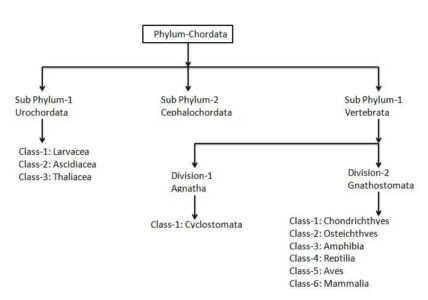
Outline Classification of Phylum Chordata
Phylum Chordata is divided into the following three subphyla:
- Urochordata
- Cephalaochordata
- Vertebrata
Among the above three sub-phyla, the major subphylum is vertebrata because it contains a variety of organisms like fishes, amphibians, birds, reptiles and mammals while the first two sub-phyla, urochordata and cephalochordata are collectively known as protochoradata that have very few species in between them which are all marine animals. Besides, the phylum vertebrata bears a distinguishing backbone that is built up of bone or cartilage. They have a brain which is enclosed in a skull. They also have proper nervous system, circulatory system, and a skeletal system that provides proper shape and support.
Sub-phylum: Urochordata
The main characteristics of urochordata are:
- They are marine animals (sessile) which are also known as tunicate and their body is enclosed in cuticular tunic or test, made up of cellulose like substance known as tunicin.
- They mostly live at the bottom of the sea.
- There are two openings on the body surface, mouth and atriopore.
- Pharynx forms large sac with perforated walls which act as an organ of respiration and food capture.
- They bear notochord only in the larval stage but in the adult stage, it disappears.
- In the adult, nervous system is reduced to a ganglion.
- Coelom is reduced which is restricted within pericardium.
- They are hermaphrodite (sexes are united).
- They show sexual or asexual reproduction. In this case, asexual reproduction occurs by budding. In a few cases, alternation of generation occurs.
- Larva is free swimming tadpole larva which contains a notochord and dorsal hollow nerve cord in the caudal region but nerve cord is replaced by a dorsal ganglion in adults.
- At the adult stage, they show retrogressive metamorphosis and lose their tail and notochord.
- The adults are fixed to the substratum.
- Larval forms are free swimming; some are solitary or form colonies.
Examples:Ascidia mentula , Salpa fusiformis, Doliolum nationalis.
The sub-phylum Urochordata contains the following three classes:
Class-1: Ascidiacea
- Adult is sessile, unable to swim and the sac-like body remains attached to any aquatic objects.
- Oral and atriporal aperture are close at the proximal free-end.
- Spacious pharynx bears numerous pharyngeal gill-slits.
- Chordate characteristics disappear in the adult but it persists in the larval stage.
Example:Ascidia mentula
Class-2: Thaliacea
- Adults are incapable of swimming.
- Oral and atriporal apertures are at opposite ends.
- Muscles are arranged in complete or incomplete circles.
- Two large and numerous small gill-slits are present.
Example: Doliolum denticulatum
Class-3: Larvacea
- Adult contains notochord in the tail region;
- They are capable of swimming.
- Minute animals without atriporal opening or atrial cavity.
- There is only two gill-slits.
- Gill-slits communicate directly with the external environment.
Example:Oikopleura longicaudata
Sub-phulum: Cephalochordata (Acraniata)
- They are Fish-like marine animals with laterally fattened body devoid of paired fins, skull and limbs.
- They possess tail throughout the life.
- Single-layer epidermis; oral hood with cerii;
- The notochord is found throughout life which extends forward to the anterior end of the snout, in front of the nerve cord.
- Presence of dorsal tubular nerve cord.
- Pharynx large, sac-like and perforated with numerous well-developed pharyngeal gill slits.
- Blood is colorless; circulatory system without heart.
- Ciliated nephridia serve as the excretory organs, U shaped with solenocytes.
- Coelom well-developed and enterocoelic in development.
- Muscles (V-shaped myotomes) and gonads are metamerically arranged.
- Gonads without ducts.
- Long larval life; larva asymmetrical.
- Progressive metamorphosis occurs in their life cycle.
Examples: Mediterranean amphioxus or European lancelet: Branchiostoma lanceolatum
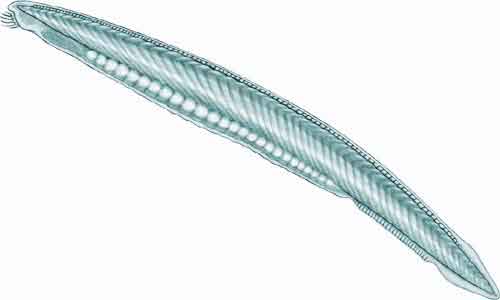
Bracnchiostoma lanceolatum
Sub-phylum: Vertebrata (Craniata)
The sub-phylum vertebrata incorporates the remarkable chordates which occupy high taxonomical ranks. All the vertebrates are placed under the single sub-phylum Vertebrata or craniata. The vertebrate possess a ‘back-bone’ which is the most characteristic features of the vertebrates. Thus, a vertebrate is defined as an animal having back bone consisting of a series of small bones (ring-like)or cartilage running throughout the length of the body along the mid-dorsal side, enclosing and protecting the spinal cord. On the other hand, all animals which do not possess vertebral column, are known as invertebrate. The vertebrates have acquired a number of characteristics features in addition to the basic chordates characterizes which are of high adaptive value and as much they are readily distinguished from the invertebrate-chordates.
Characteristics of sub phylum Vertebrata
- Presence of endosketetal framework, and exoskeletal structures.
- In the adult stage, the notochord is replaced by a vertebral column.
- Presence of cranium or brain-box accompanied with a vertebral column; the vertebral column is composed of segmented cartilaginous or bony rings, known as vertebra.
- Multi-layered epidermis is present.
- They possess well-developed coelom.
- They have a high degree of cephalization or distinct head.
- The neural tube is specialized to form the complex brain; the brain is associated with special sense organs.
- Presence of visceral arches which are variously modified in different groups vertebrates.
- Paired lateral appendages are present in the form of limbs or fins.
- Circulatory system consisting of a ventral thoracic heart and shows increasing structural complexities in keeping the oxygenated blood separate.
- They have complete alimentary canal.
- Respiratory and excretory systems are well-developed.
- Three or four-chambered heart is present.
- Endocrine glands are present and well-developed.
Sub Phylum Vertebrata is further classified into the following classes. They are:
- Class-1; Cyclostomata
- Class-2: Chondrichthyes
- Class-3: Osteichthyes
- Class-4: Amphibia
- Class-5: Reptilia
- Class-6: Aves
- Class-7: MammaliaAmc
Class-1: Cyclostomata
- They have long, rounded and eel-like body with scale less, glandular and smooth skin.
- Mouth is circular in shape and suctorial with devoid of functional jaws.
- They have no jaws; the skull is largely or completely roofed by membrane.
- Notochord is persistent and unconstructed.
- Skeleton is wholly cartilaginous; vertebrae incipient as sticks.
- They have neural tube with rudimentary neural arches.
- They have median fin but paired fins or lateral appendages are absent.
- Fins are not supported by true fin rays.
- Gill pouch-like and paired.
- Absence of conus arteriosus and renal portal system.
- Spleen and genital ducts are also absent.
- Nasal organ is unpaired with a long sac extending beneath the brain.
- The gonad is single without duct; gametes pass through the genital pores.
- They inhabit in marine habitat but migrate for spawning to fresh water.
- Development is indirect or direct.
Examples:Petromyzon marinus (Lamprey) and Myxine glutinosa (Atlantic Hagfish).
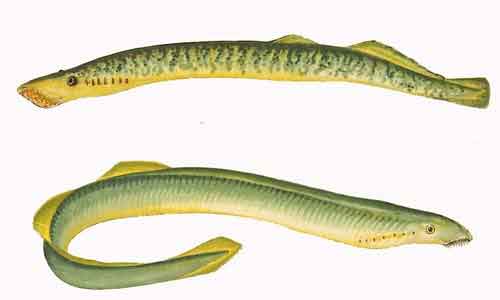
Petromynus marinus (Lamprey)
Class-2: Chondrichthyes
- They have streamlined body with cartilaginous endoskeleton.
- They have ventrally positioned mouth.
- The body contains tough skin with minute placoid scales.
- They have powerful jaws with backwardly directed teeth.
- They have 5-7 pairs of gill slits without operculum.
- Some species have electric organs such as Torpedo and some bear poisonous sting such as Trygon.
- They posses both paired and median fins which are not supported by fin rays.
- They have heterocercal tail; in this case, tail is unequally bifurcated.
- Sexes are separate and in male, pelvic fin is provided with a pair of claspers.
- Gonads are typically paired and provided with ducts that open into the cloaca.
- Intestine bears a spiral valve.
- Fertilization is internal, development is direct; many of them are viviparous which give birth to young baby.
Examples:Scoliodon laticaudus (Dog fish), Pristis clavata (Saw fish), Carcharodon carcharias (Great white shark), Dasyatis thetidis (Sting ray).
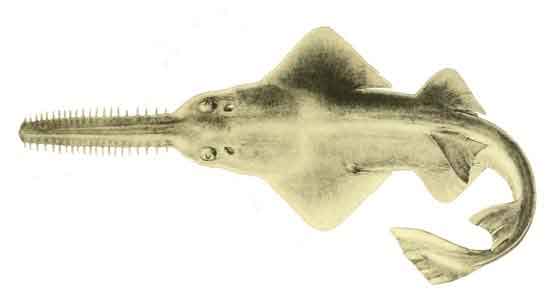
Pristis clavata
Class-3: Osteichthyes
All bony fishes belong to the class Osteichthyes. All the representatives of Osteichthyes are cold-blooded which bear one pair of gill openings for breathing and different types of fins for swimming. Besides these, they have bony skeleton, jaws and one pair nostrils. The class Osteichthyes is the largest group of vertebrates in the world and it contains more than 30,000 fish species which account for about 96% of all fish species. This class does not contain sharks, rays, skates, lampreys and hagfishes. They have very keen sense organs with very good eyesight. They take a wide variety food, among them, some are herbivores, some carnivores and some take any kind of food at all(omnivores).
- They inhabit in all sort of waters such as fresh, marine, brackish-water environment.
- They have streamlined body with terminal mouth.
- They have bony endoskeleton. In this case, at the embryonic stage, endoskeleton is cartilaginous but it is replaced by bones in the adult stage.
- They have usually homocercal symmetrical caudal fin.
- The body skin is covered by different types of scales such as ctenoid, cycloid or ganoid scales, which are dermal in origin.
- Alimentary canal is complete with no cloaca.
- There are four pairs of gills which are covered by an operculum on each side.
- They have sac-like outgrowth which is known as swim bladder or air bladder. It is air filled organ arising from the dorsal wall of the oesophagus. It helps to maintain buoyancy and in some fishes such as catfish, it helps in respiration.
- Lateral line system is well-developed which stars from the end of the operculum and ends at the base of the caudal fin.
- They have well developed renal portal system with mesonephric kidneys. During excretion, they release chiefly nitrogenous waste.
- They have 2-chambered heart, one auricle and one ventricle with sinus venosus and conus arteriosus. But in the lung fishes, the heart is three chambered with two auricles and one ventricle.
- Sexes are separate and they usually perform external fertilization.
- They are mostly egg laying fish (oviparous), some are ovoviviparous and their development is direct. In few cases, development is indirect with a larva, known as leptocephalus such as Anguila.
The class Osteichthyes is divided into the following two subclasses:
- Subclass-1: Actinopterygii
- Subclass-2: Sarcopterygii
Subclass-1: Actinopterygii
- They are also known as ray-finned fishes due to lepidotrichia or fin rays.
- Fin rays are attached directly to the proximal or basal skeletal elements, known as the radials.
- It is the dominant group of vertebrates which comprises nearly 99% of the more than 30,000 fish species.
- They inhabit throughout marine and freshwater environments.
- The skin of the body is covered by scales like cycloid, ctenoid or ganoid. In some fishes such as silurids, scales are absent.
- Generally, they do not have any spiracles.
- On the top of the head, external nare is present.
- They possess either heterocercal or homocercal type caudal or tail fins.
- Endoskeleton is composed of either bones or cartilages.
Examples:Labeo rohita, Catla catla, Anabas testudineus, Lates calcarifer, Tenualosa ilisha, Ompok pabo, Heteropneustes fosilis
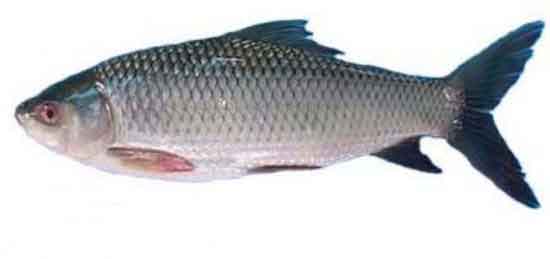
Labeo rohita
Subclass-2: Sarcopterygii
- They are also known as fleshy finned or lobe-finned fish due to their lobed appearance fins.
- Thick, pitted rhomboidal shaped ganoid scales are present on the body with cosmoid layer characteristics.
- Heterocercal type caudal fin is found in the primitive species but diphycercal type caudal fin is present in the recent forms.
- They have reduced type dorsal fin.
- They perform respiration through lungs. In this case, swim bladder is replaced into lungs.
- Basal element of pectoral fins is attached to the girdle with a branching arrangement at the tip.
- Internal nares are present which opens into the buccal cavity through a pore, called choanae.
- Vertebral column continues up to the tail end which divides the tail into upper and lowers lobes.
Examples:Latimeria chalumnae, Neoceratodus forsteri, Lepidosiren paradoxa, Protopterus aethiopicus
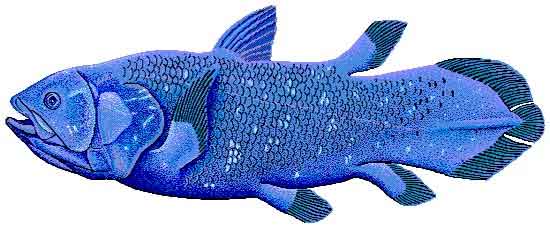
Latimeria chalumnae
Class-4: Amphibia
The term ‘amphibian’ is derived from the Greek word ‘amphíbios’ meaning both kinds of life. They are cold-blooded vertebrate tetrapods which inhabit a wide variety of habitats, including terrestrial, arboreal, fossorial, or freshwater aquatic ecosystems. There are approximately 8,100 species, of which, about 90% are frogs. Paedophryne amauensis is the world smallest amphibians, found in Papua New Guinea which grows up to 7.7 mm in length while the largest living amphibian is Andrias sligoi (South China giant salamander) which grows up to 1.8 m in length (5 ft 11 in).
General Characteristics of Class Amphibia
- They can live in both aquatic and terrestrial habitats.
- The body is divided into two regions such as head and trunk. In some cases, the tail may be present.
- The body does not contain any scales. The skin may be smooth or rough with mucus glands which make the body moist.
- Two pairs of limbs, namely forelimbs and hind limbs with no claws on their digits (toes) which are used for locomotion.
- They perform respiration through the lungs and moist skin. In some adults, external gills are present for respiration.
- They have mesonephric kidneys and they release ammonia and urea as nitrogenous waste products.
- Fertilization is external and development is mostly indirect. Some amphibians perform internal fertilization such as Salamander and Ichthyophis (blind worm).
- Most of the amphibians are oviparous and they lay eggs. Some are viviparous such as Salamander.
- During their life cycle, a fish like larva occurs which is known as tadpole larva.
- Heart is three chambered with two auricles and one ventricle.
- The eyes have eyelids to prevent the eyes from external injury.
- A common chamber, known as cloaca is present where alimentary canal, urinary and reproductive tracts opens which collects discharge products before it is eliminated from the body.
- They have well-developed brain which is attached to a dorsal nerve cord.
- They are ectotherm organisms and they either hibernate (winter) or aestivate (summer) during extreme environmental conditions.
- They possess a well-developed muscular system.
- They have well-developed digestive system which is adapted to digest whole prey, swallowed by the organism.
- They possess well-defined liver which performs several functions such as producing bile, detoxifying poisons, and storing glucose in the form of glycogen.
- They possess a pressure releasing canal which is known as the Eustachian tube that connects the mouth cavity with the tympanic membrane.
Examples: Tailed frog (Ascaphus truei), European fire-bellied toad (Bombina bombina), tiger salamander (Ambystoma tigrinum), Limbless amphibians (Ichthyophis glutinosus).
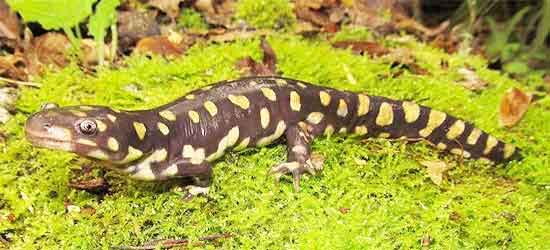
Tiger salamander (Ambystoma tigrinum)
You might also read: Detailed Classification of Amphibia
Class –6: Reptilia
The word reptile comes from Latin “Reptilis’ meaning creeping. They are the creeping and burrowing vertebrates with epidermal scales. There are about 8,000 living reptiles species in the world today that inhabit all continents on Earth except Antarctica. It includes verities group ectothermic vertebrates including lizards, snakes, crocodiles, alligators, turtles, caimans and worm-lizards, etc. They can inhabit different type habitats such as forests, deserts, freshwater wetlands and the open seas.
- They are cold-blooded animals (poikilothermal).
- They have two pairs of pentadactyl limbs, each with five clawed toes, often reduced or absent.
- Skin is dry, and it is covered with horny epidermal scales often with underlying bony dermal plats; few cutaneous glands are present in skin with high levels of keratin that stops water loss through the skin.
- Usually, they have post-anal tail.
- They are completely lung breathers; no skin or gill respiration.
- Heart is imperfectly four-chambered, two auricles, the ventricles being divided incompletely by a septum into two. Sinus venosus opens into right auricle, no conus and truncus arteriosus.
- Functional kidney, metanephros with metanephric ureters.
- Cloaca is present which gives space to receive rectum, ureters and genital ducts; cloacal opening is transverse.
- Digestive system is complete which has a muscular opening at the base of the tail.
- They have a well-developed brain and a central nervous system with twelve pairs of cranial nerves.
- Foetal membranes consist of amnion, chorion and allantois.
- Sexes are separate; fertilization is internal with direct development.
- They are mostly oviparous, but viviparity is seen in some snakes, some of which are ovo-viviparous.
Examples: Green sea turtle (Chelonia mydas), Aldabran giant tortoise ( Aldabrachelys gigantea ), Spectral pygmy chameleon (Rhampholeon spectrum), Oriental Garden lizard (Calotes versicolor), Saltwater crocodile (Crocodylus porosus), Naja naja (Cobra), Indian Krait ( Bangarus caeruleus),Horned viper ( Vipera ammodytes).
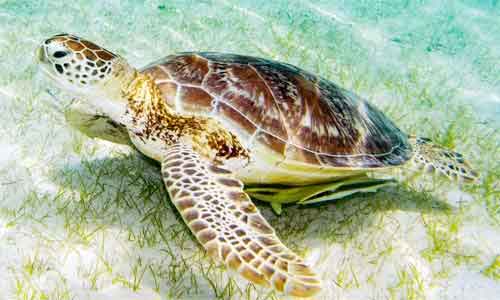
Green sea turtle (Chelonia mydas)
You might also read: Detailed Classification of Extant Reptiles
Class –6: Aves
All birds belong the class Aves, they are egg-laying endothermic vertebrate animals. There are about 10,000 living species of birds in the world that inhabit in nearly all habitats on Earth. It constitutes the largest number of species among the tetrapod classes.
- They are homoiothermous or warm-blooded animals and they can maintain a constant body temperature.
- The body is covered with special integument derivatives, known as feathers, the nature`s masterpiece.
- Their body is very light with pneumatic bones.
- The skin is thin, loose and dry with flight muscle in the thorax; sweat gland is absent.
- At the base of the tail, uropygeal or preen gland is present.
- Forelimbs are modified as wings for flight while the hind limbs are covered with scales and armed with claws which are concerned with bipedal locomotion.
- The hind limbs generally bear scales and are modified for swimming, walking, or clasping the branches of trees.
- Horny, hard beak or bill is present.
- Mouth does not bear teeth.
- Head is small and round with a fairly long, flexible and movable neck.
- Alimentary canal contains additional chambers, the crop and gizzard which are highly developed in grain-eating bird.
- Gall-bladder is absent and rectum opens into a cloaca with tree differentiated compartments.
- They have no urinary bladder.
- Respiratory system can perform a double respiration. In this case, air sacs are connected to lungs which ensure supplement respiration.
- Lung is small, elastic and is affixed in the dorsal wall of the thorax and give rise to some air-sacs to increase its efficiency.
- The sound producing organ, known as syrinx is present
- The heart is completely four-chambered; sinus venosus and conus arteriosus are absent.
- Excretory organ, known as kidney is metanephric, urine is semi-solid.
- Eyes are large in size and powerful with a specialized structure, known as pectin.
- They are oviparous and they lay eggs with large yolk which is covered by a hard-shell.
- Sexes are separate; fertilization is internal and their development is direct.
Examples :Corvus splendens ( house crow), Columba livia (Domestic pigeon), Indian vulture (Gyps indicus) etc.
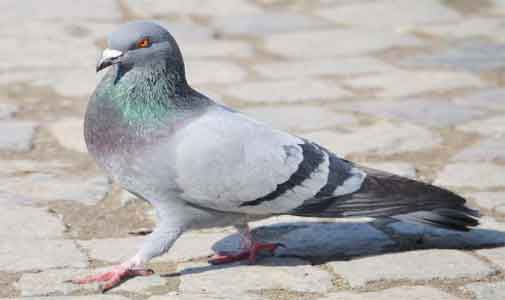
Columba livia
You might also read: Classification of Aves in details
Class-7: Mammalia
The word ‘Mammalia’ is derived from Latin word ‘mamma’ meaning “breast”. The class Mammalia includes the vertebrate animals which contain mammery glands. These glands are active in female and produce milk for feeding their babies. These vertebrate animals are also characterized by the presence of fur or hair, a four-chambered heart and three middle year bones which distinguish them from birds and reptiles. There are about 5500 living mammal species under 161 families and 29 orders. The rodents, bats and shrews constitute the largest order which is followed by the Primates, Cetartiodactyla and Carnivora, respectively.
- The mammals are ectothermic (warm-blooded) animals which bear four-chambered hearts.
- Most of the mammals give birth to live young babies except Platypus and the Echidna which lay eggs.
- They inhabit variety of habitats such as grasslands, deserts, polar ice caps, forests, mountains, dark caves and even some of them can adapt to fly or live in water.
- They have two pairs of limbs which are used for walking, climbing, running, burrowing, flying or swimming.
- The skin of mammals is unique which possesses hair and oil glands such as sebaceous glands and sweat glands. In this case, hair or fur helps animals adapt to their environment.
- They have well-developed brain which is divided into cerebrum, cerebellum and medulla.
- They perform respiration through lungs.
- They have 12 pairs of cranial nerves and exhibit one of the most highly developed forms of Diaphragms
- Sexes are separate and they perform internal fertilization.
- Most of them are viviparous with few exception and they show direct development.
Examples: Oviparous – Platypus (Ornithorhynchus anatinus); Viviparous – Royal Bengal Tiger (Panthera tigris),Red kangaroo (Macropus rufus), flying fox (Pteropus vampyrus), Short-beaked common dolphin (Delphinus delphis) , blue whale (Balaenoptera musculus) , etc.
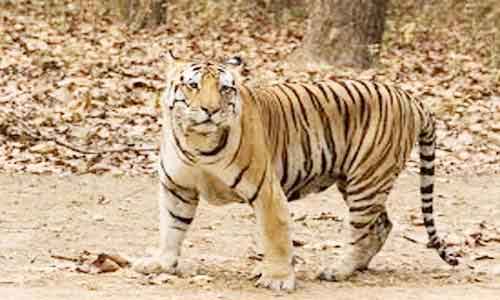
Royal Bengal tiger (Panthera tigris)
Difference Between Chordates and Non-chordates
| Chordates | Non-chordates |
|---|---|
| They are cold or worm blooded organisms. | They are cold blooded organisms. |
| Notochord is present at some stage or it is replaced by a ring like vertebrae at adult stage. | Notochord or backbone is absent. |
| They have central nervous system which is dorsal, hollow and single. | In this case, central nervous system is ventral, solid and double. |
| Pharynx is perforated by gill-slits. | In this case, gill-slits are absent. |
| They perform respiration through gills or lungs. | They perform respiration through body surface, gills,or tracheae. |
| The position of heart is ventral. | Usually, the heart is absent, if present the position of heart is dorsal or lateral. |
| A post-anal part or tail is present. | In this case, post-anal tail is absent. |
| They are true coelomate organisms. |
They may be acoelmate, pseudocoelmate or truly coelmate organisms. |
| Blood vascular system is closed type. | Generally, blood vascular system is absent; if present, it may be open or closed type. |
| Their body is bilaterally symmetrical. | Their body is radial, bi radial, bilateral or without symmetry. |
| Nerve cord is single, dorsal, without ganglia. | Nerve cord is double, ventral, usually with ganglia. |
| The gut is situated ventral position to nerve cord. | In this case, gut is found dorsal position to nerve cord. |
| They mainly perform sexual reproduction.Enter your text here… | In this case, asexual reproduction is predominant. |
| Their regeneration power is usually poor. | Their regeneration power is usually good. |
| They possess both exoskeleton and endoskeleton | In this case, only exoskeleton is present. |
| Examples: Hemichordates, Cyclostomes, Aves, Reptiles, Amphibians, Mammals , etc. | Examples: Protozoans, Annelids, Arthropods, Echinoderms, etc |
Concluding Remarks
Chordates are animals which belong to the phylum Chordata. This phylum consists of three groups, namely vertebrates, tunicates, and lancelets. The members of chordates are very essential for an ecosystem because they keep up the ecosystem. Chordates consist of 43,000 living species which can consume and hunt down other types of animals and maintain of predator and prey role. Many chordates provide food for human beings and many chordates release their excretion to the environment, provide nutrients and minerals to the ecosystem which boost up the plants growth.
You might also read: Chondrichthyes Vs Osteichthyes:General Characteristics and Differences

